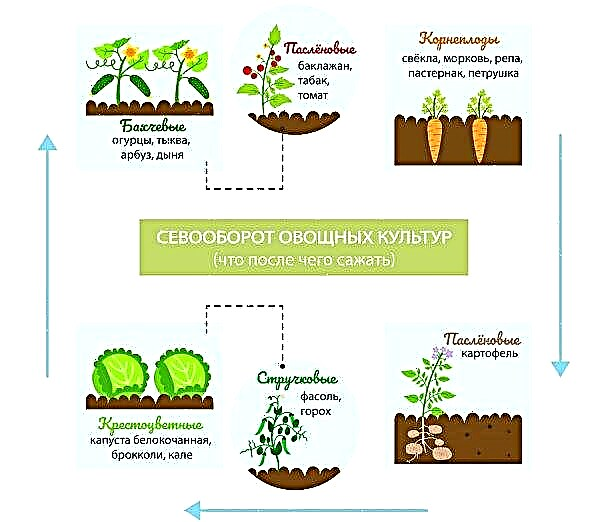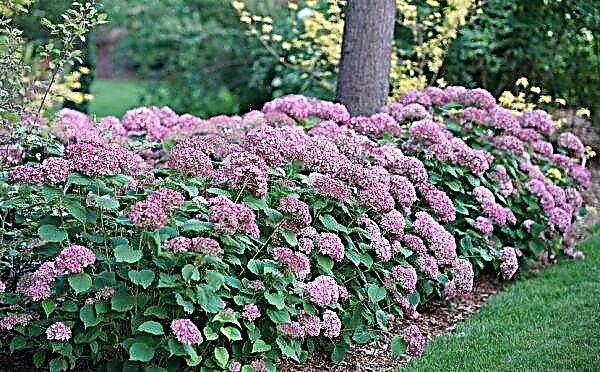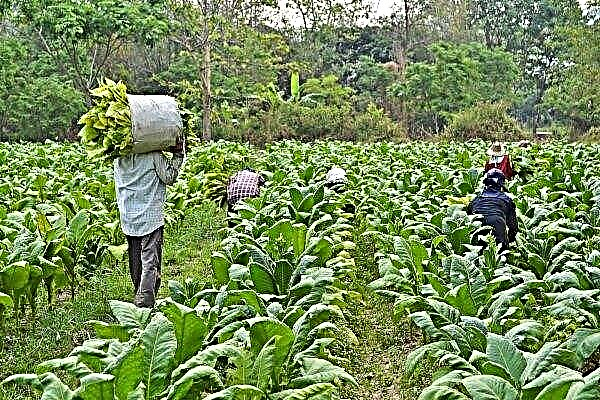Fir is an evergreen tree with a beautiful appearance, due to which it is often used in landscape design. The lack of drying over the years of the lower branches and the multi-colored needles that characterize many varieties give the plant a special appeal. However, like all representatives of the flora, fir can be subjected to various diseases and attacks of annoying insects, so each owner of these luxurious trees must know how to recognize the ailment and conduct treatment.
Why do diseases appear and can they be cured
Most fir diseases are directly related to non-compliance with the rules of planting and plant maintenance. Fir needs lighted spacious areas. If you plant a small tree surrounded by fast-growing deciduous crops, it will certainly begin to hurt. The same applies to the stay of the plant in waterlogged soil, as a result of which the root system often suffers, rotting processes are launched, which can lead to death.
Important! It is not recommended to plant fir in urban areas, near roads, since the tree is very sensitive to atmospheric pollution.
One of the violations of the rules of agricultural technology is the lack of top dressing, which is why the immune system of fir is weakened and cannot resist infections and pest attacks. Improper care of the culture provokes the occurrence of fungal infections. Diseases can also be carried by wind, groundwater or pests. Often, the poor quality of planting material, which already contains signs of diseases, affects rotten fragments, cracks, etc. The development of a culture can be affected by the destruction of an earthen coma during planting or its overdrying. For the most part, fir diseases respond to treatment, which sometimes is very delayed. But there are also ailments against which, unfortunately, no effective control measures have yet been developed.
Often, the poor quality of planting material, which already contains signs of diseases, affects rotten fragments, cracks, etc. The development of a culture can be affected by the destruction of an earthen coma during planting or its overdrying. For the most part, fir diseases respond to treatment, which sometimes is very delayed. But there are also ailments against which, unfortunately, no effective control measures have yet been developed.
Diseases and their treatment
Fir is most often affected by fungal infections and cancer. Moreover, if it is quite possible to fight and win against fungal infections, then in the case of cancerous lesions, any treatments are effective only at the initial stages of development. Neglected cancers are not treated, and the affected trees are uprooted and burned.
Important! Chemical treatment should be carried out in dry, calm weather. Spraying in the hot time of the day can provoke burns of needles, and in the rainy — to be inconclusive.
Rust
Rust is a fungal disease that can be determined by the appearance of orange blisters on the needles. All these are signs of sporulation of the fungus. Over time, the greens begin to dry out and die. In adult trees with a certain immunity, the course of the disease is slowed down, in young, recently planted firs, it passes at a rapid pace - if measures are not taken in time, the trees will soon die. To cure the disease, you should seek the help of fungicide preparations, such as, for example, “Skor” or “Rayek”. They are bred in water according to the instructions and sprayed wood and crown.
To cure the disease, you should seek the help of fungicide preparations, such as, for example, “Skor” or “Rayek”. They are bred in water according to the instructions and sprayed wood and crown.
Video: rust on plants
Schütte
Brown shute is an ailment caused by the fungus Herpotrichia guniperi. It progresses on plants in the winter under a dense layer of snow. The longer the snow cover remains on the crown, the greater the likelihood of a fungus infection. During a thaw on a sick shute, fir needles can be found in a thick brown-black coating.
The needles begin to dry quickly, acquiring a dark red shade, but do not fall off, but remain on the shoots, being glued with mycelium. The effective chemicals Acrobat, Profit, and Ordan will help save the trees. To achieve a more effective result, it is recommended to process plantings several times.
Fading of shoots as a result of fungal infection
The disease is characteristic of Siberian fir, but the possibility of damage to the fungus and other species is not excluded. When the shoots die off, the tips of the needles may turn red, and then rust and completely dry out. The lower parts of the trees die off - they lose their branches and needles, and the crown remains only at the top, as a result of which the decorativeness of the culture suffers.
Fir needs to be rescued immediately, at the first appearance of symptoms, since a later intervention at the stage of dying off of shoots may be inconclusive. First of all, all affected areas should be cut off. Then the trees are treated with Vitavax fungicide or Bordeaux liquid, according to the instructions.
Rust cancer
The cunning of this disease lies in its long course, during which the tree not only suffers from a fungal infection, but also becomes an easy "prey" of harmful insects. In the initial stages of rust cancer, thickening of fir shoots, the formation of growths on the trunk, and needles rusting are observed. The initial stage, as a rule, occurs in the spring, when young shoots are affected and thickenings form. A year later, “witches brooms” grow out of these seals - strong branching branches that indicate infection.
By summer, fungal spores develop on the back of the brooms, which can be determined by yellow-orange pads about 1 mm long. Mature spores are easily dispersed by the wind, and this is a great danger to the neighboring not only coniferous, but also deciduous crops. The disease can last quite a long time - gradually the fungus penetrates the core of the trunk and destroys the fir. To prevent this from happening, you should start treating the plant in time, because in this case, any treatment can suspend the disease only in the first stages. The drug "Racurs" can help. It contains two effective active substances - ciproconazole and epoxyconazole, which have an eradicating effect, prevent the emergence and development of pathogen spores. For processing, make a solution according to the instructions and spray them with fir. In the later stages, when cancerous tumors cover more than ½ of the circumference of the trunk, the tree will have to be uprooted and burned. In this case, it is necessary to treat the neighboring plantings with fungicide.
The drug "Racurs" can help. It contains two effective active substances - ciproconazole and epoxyconazole, which have an eradicating effect, prevent the emergence and development of pathogen spores. For processing, make a solution according to the instructions and spray them with fir. In the later stages, when cancerous tumors cover more than ½ of the circumference of the trunk, the tree will have to be uprooted and burned. In this case, it is necessary to treat the neighboring plantings with fungicide.
Bacterial dropsy
The causative agent of this disease is a bacterium from the genus Erwinia. The affected fir is characterized by a change in the color of the needles - at first it turns yellow, then acquires a brown color, and in the advanced stage it becomes dirty gray. Moreover, a color change can occur on any part of the plant - at the top, bottom, side or on separate branches.
Excess liquid and gas accumulate in the trunk of the fir, resulting in a rupture of wood and bark under pressure, and fractures are formed. With bacterial dropsy, one can notice how a liquid with an unpleasant sour smell seeps out from small cracks in the trunk (cancerous lesions). The wood gradually dries up, rot and pest insects progress on it. As a result, the fir dies. This disease was established recently, in connection with this, there is practically no experience in dealing with it. If symptoms of the disease are detected, cutting down the tree and its subsequent destruction is recommended.
As a result, the fir dies. This disease was established recently, in connection with this, there is practically no experience in dealing with it. If symptoms of the disease are detected, cutting down the tree and its subsequent destruction is recommended.
Rot
Rot is the common name for a number of ailments caused by the progression of various kinds of fungi.
This group includes diseases such as:
- Mottled rot - the infection infects the tree from the root and rises up the trunk, hitting its core to a height of 4 m. In the first stage of variegated rot, the wood may turn red, it starts to exude an unpleasant smell of turpentine, it becomes soft. In the process of the development of the disease, the fruiting bodies of the fungus grow near the roots, and the wood is completely destroyed.
- White fibrous - rot, able to climb the trunk to a height of 10 m and hit on its way all fragments of wood, destroying it. The disease is determined by white fibrous traces with the finest sinuous black lines.
- White sapwood - It affects the outer layers of wood (sapwood), where the main physiological processes take place. The causative agent of this disease is autumn honey agaric, which grows in the affected areas during the course of the disease, rising to a height of 3 m. It is characterized by the appearance of white fan-shaped films (mycelium) under the bark of the plant with thin dark brown blotches.
All types of rot carry a huge danger to fir. They lead to a gradual weakening of trees, their drying out. In addition, infections can provoke the formation of large areas of distribution of insect pests, so it is very important to take timely measures. In the initial stages, spraying the crown with a fungicide will help, for example, the Champion remedy works well, it is additionally recommended to pour the soil of the stem circle with the solution of Fundazole (40 g per 20 l of water). In running versions, trees are subject to removal and destruction.
In the initial stages, spraying the crown with a fungicide will help, for example, the Champion remedy works well, it is additionally recommended to pour the soil of the stem circle with the solution of Fundazole (40 g per 20 l of water). In running versions, trees are subject to removal and destruction.
Pests and the fight against them
In addition to diseases, insects can pose a threat to fir. Their list is quite impressive, but gardeners should not despair: if you discover pest populations in time, it is not difficult to save the tree with the help of chemical treatments.
Did you know? Insects appeared on planet Earth more than 400 million years ago and are recognized as its first inhabitants.
Hermes
Hermes are sucking pests that cause great harm to fir and other conifers. Particularly enhances the harmfulness of the rapid reproduction of a pest that feeds on plant sap. You can determine its presence by the appearance of a white or grayish gun on the kidneys or at their base.
There is also a curvature and falling of needles, the appearance of ugly galls on young shoots. During the growing season, Hermes are able to give up to 5 generations, so you have to deal with them constantly. Spraying should be carried out in spring and summer using insecticides. It is better to change the funds periodically so as not to cause addiction in insects. The first treatment is carried out in late April with Actellik or Decis Pro preparations, the second in Aktara in mid-May, and the Confidor Maxi in early June. The fourth and fifth treatments are carried out in July and August using systemic insecticides Engio and Aktara.
It is better to change the funds periodically so as not to cause addiction in insects. The first treatment is carried out in late April with Actellik or Decis Pro preparations, the second in Aktara in mid-May, and the Confidor Maxi in early June. The fourth and fifth treatments are carried out in July and August using systemic insecticides Engio and Aktara.
Scaffolds and false shields
Both of these insects are equally harmful to fir. Their difference lies in the structural features. In scutes, the carapace has a flat shape and is not spliced with the body. The pest has a pea-shaped shield and is tightly attached to the body with tissues. Insects stick to the needles with a proboscis and drink the juice coming under pressure.
You can determine their appearance on fir by needles, which begin to fade and crumble, as a result of which the plant quickly loses its decorativeness. You can get rid of scale insects and false shields using the drug "Aktara". A highly concentrated solution should be made: 4 g of the product in a bucket of water. Consider that it will be needed quite a lot, so much as to cultivate the soil around the entire perimeter of the crown and about 1 m more from it. The essence of the treatment is that after you nourish the ground around the fir with an insecticide, the poison enters the root system, and from there - further to the shoots and cones. Insects that feed on the sap of the plant will, accordingly, absorb the poison and die. First you should water the soil well, then treat it with Aktara solution and water it again to eliminate poison from the soil surface. In addition, it is worthwhile to carry out several sprayings of the crown with an interval of 2 weeks with the preparations "Enzhio" or "Calypso".
The essence of the treatment is that after you nourish the ground around the fir with an insecticide, the poison enters the root system, and from there - further to the shoots and cones. Insects that feed on the sap of the plant will, accordingly, absorb the poison and die. First you should water the soil well, then treat it with Aktara solution and water it again to eliminate poison from the soil surface. In addition, it is worthwhile to carry out several sprayings of the crown with an interval of 2 weeks with the preparations "Enzhio" or "Calypso".
Spider mite
This is one of the most common pests, a characteristic sign of the presence of which is a coating of a thin white web. When a tick appears on the needles, yellowish spots can be found, which then acquire a darker brown shade, as a result of which the greenery crumbles.
The insect causes the greatest harm in dry, hot weather, when the fir is not enough moisture. You can get rid of this pesky guest, which, incidentally, breeds rapidly (over the summer the female gives about 5 generations), you can use 3-time treatment with one of the acaricidal preparations, such as Nurel-D or Caesar.
Video: spider mite
Moth
The moth is a small yellowish-gray butterfly, the wingspan of which does not exceed 3 cm. Fir for it is the main source of food. At the beginning of the 20th century, the invasion of moths damaged about 1 million hectares of fir plantations in the forests of East Sayan. The insect activates in May, lays larvae under the scales of the bark and in the cracks of the wood, from which caterpillars appear in July. Insects eat around needles, which then dry out, twist and fall. The tree can be cured by spraying with the Lepidocide biological product, which is diluted with water at the rate of 30 g per 10 liters.
The insect activates in May, lays larvae under the scales of the bark and in the cracks of the wood, from which caterpillars appear in July. Insects eat around needles, which then dry out, twist and fall. The tree can be cured by spraying with the Lepidocide biological product, which is diluted with water at the rate of 30 g per 10 liters.
Leaflet
Symptoms such as united growth points and young shoots, on which spider nests are also noticeable, indicate the presence of a leaf moth on the fir. Adult caterpillars of these butterflies reach a length of 20 mm, have a grayish-green color, and their body is covered with small warts with villi. Damaged areas of the tree must be cut and burned. Processing should be carried out in several stages with an interval of 10-14 days. Then, the plant should be treated with chemical preparations, the best of which in this case will be Fufanon, Karbofos. Of these, you need to make a solution, diluting in water at the rate of 10 ml of the drug per 10 liters. In severe cases, you can double the dosage. Keep in mind that leafworm larvae quickly move from one crop to another in the garden, therefore, in addition to the affected fir, neighboring plants must also be treated.
Processing should be carried out in several stages with an interval of 10-14 days. Then, the plant should be treated with chemical preparations, the best of which in this case will be Fufanon, Karbofos. Of these, you need to make a solution, diluting in water at the rate of 10 ml of the drug per 10 liters. In severe cases, you can double the dosage. Keep in mind that leafworm larvae quickly move from one crop to another in the garden, therefore, in addition to the affected fir, neighboring plants must also be treated.
Cone fire
It was no coincidence that the insect got its name - the main harm that it brings to fir is that a fire-mill gnaws cones and eats seeds from them. Insects also hit the tops of shoots, can settle in the existing tissues affected by the fungus, pierce the moves in the trunk and branches. To identify the pest, you should carefully consider the bumps - you can notice drooping red-brown masses of excrement on them.
At the same time, yellowing of the needles on the damaged shoots is observed. You can get rid of fir from settling a firetool with the help of systemic insecticides, since the insect hides inside the cones. In this case, the preparations “Fosbetsid” or “Fozalon” will help, which have a contact-intestinal effect - they penetrate into the tissues of the plant and with them into the food by insects, destroying them.
Video: cone cone
Nutcracker Beetles
The name of the nutcracker is not given by chance: if you touch the insect, it simulates death, but when you flip it on its back, the beetle jumps and emits frightening clicks. This is due to a special mechanism - the thoracic process, which, in case of danger, sharply straightens. However, it is not so much the beetles themselves that are dangerous that their larvae are. Staying in the ground, they gnaw the roots of fir - first thin, and then thicker.
Such harm causes a weakening of the root system, as a result of which drying and shedding of needles, and sometimes whole branches, can be observed. The most favorable conditions for the life of nutcrackers are wetlands with high acidity. To control the pest, the Bazudin insecticide is most often used.In autumn, it is advisable to water the soil with potassium chloride and dig it thoroughly.
Disease and Pest Prevention
To protect the tree from diseases and attacks of parasitic insects, first of all, you need to follow the basic rules of agricultural technology regarding planting and care. If you notice even the slightest damage on the seedling, it is better to repair them or completely refuse to plant such material. Correctly place the seedling in the pit - the root neck should not be deepened, otherwise it will lead to its decay.
Did you know? Fir — long-lived tree. Under favorable conditions, she can live 300–500 years and some species — up to 700 years.
Fir loves moist soils, but not wetlands, creating favorable conditions for the development of fungi. At the same time, excessive drought will also negatively affect fir, so in the hot summer you need to ensure that the soil is sufficiently moistened. It is also recommended to conduct 2-3 times a week spraying needles with cool water - this measure will help prevent the appearance of spider mites.
Do not forget to timely feed the soil in the area with conifersbecause fertilizers make plants stronger and resistant to various infections and pest attacks. Complex mineral fertilizers are applied in spring and summer. For spraying, you can use the foliar top dressing "Brexil Combi", and for fertilizing the soil directly - "Agrecol" or "Florovit". A good preventive measure is the treatment of fir with chemical protective agents - pesticides that can kill or stop the activity of harmful insects and fungi. You need to do it regularly throughout spring and summer, as well as in autumn, during preparation for wintering. Drugs spray the crown of trees and water the soil.
A good preventive measure is the treatment of fir with chemical protective agents - pesticides that can kill or stop the activity of harmful insects and fungi. You need to do it regularly throughout spring and summer, as well as in autumn, during preparation for wintering. Drugs spray the crown of trees and water the soil.
You can also use biological agents, such as bio-insecticide "Fitoverm" and biofungicide "Planriz". In parallel with protective agents, it is desirable to carry out treatment with biostimulants and micronutrient fertilizers, such as Zircon, Epin, Biohelat. Experts in agricultural technology advise periodically changing drugs so as not to cause parasitic organisms to get used to them.
In general, you can adhere to the following schedule:
- April - spraying "Plantafol 10/30/10" + "Brexil Mix", root treatment "Fundazol";
- May - repeat the spraying with the same preparations as in March, add “Growth concentrate” to them, root treatment of “Aktara” + potassium sulfate;
- June - spraying “Aktofit” + “Aktellik”, watering the soil with “Activin” or “Compo Blaukorn”;
- July - spraying "Confidor maxi" + "Median extra" + "Adhesive", root treatment "Complex 10.5.9";
- August - treatment of the crown “Brexil Maxi”, soil - “Antichrush” + potassium sulfate;
- October - eradicating spraying “Preparation 30-B” + “Medyan Extra”, tillage at the same time as water-loading irrigation with Planriz or Baikal preparations.
Slender, dressed in a fluffy green coat of soft needles, with vertically standing pyramids of cones - this is what every owner wants to see fir, planting it on his site. Indeed, this perennial can rightfully claim first place in the list of the most beautiful conifers, but only if it is given proper care. Remember that failure to follow the simple rules of agricultural technology can lead to very serious consequences, and sometimes irreparable.
Indeed, this perennial can rightfully claim first place in the list of the most beautiful conifers, but only if it is given proper care. Remember that failure to follow the simple rules of agricultural technology can lead to very serious consequences, and sometimes irreparable.












